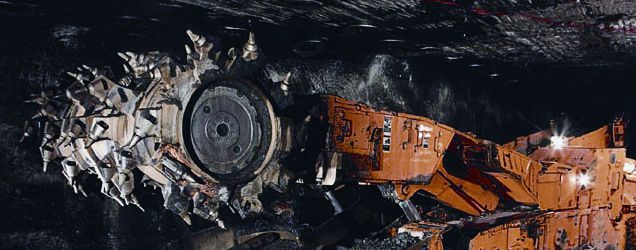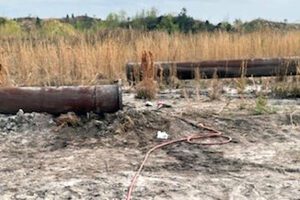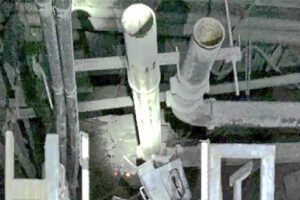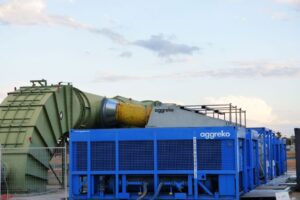Before retrofitting or modifying high-pressure hydraulic lines on longwall mining equipment, it is important to apply safe hydraulic hose fitting and mounting principles, including the use of properly rated and sized couplers, filters, and hoses designed to handle longwall system specifications.
SAFETY TIP – SAFE HYDRAULIC HOSE ASSEMBLY
Before replacing a high-pressure hydraulic hose, always shut down the pump(s), and lock-out and tag the equipment. Check the hose being replaced by twisting or squeezing it to verify the pressure has been relieved. If pressure is still in the hose, take appropriate measures to relieve the pressure before loosening the hose fittings.
Be sure to adhere to all government, industry and manufacturers specifications and standards when selecting hydraulic system components.
Two basic goals should be kept in mind when replacing hydraulic hose assemblies – make the system as leak-proof as possible, and make the system accessible for easier maintenance.
Most hydraulically operated mining equipment will come from the factory with the hoses routed properly. That is, the hose will run parallel on the piece of equipment, follow its contours and have the proper attachments. They will also have a proper layout with regard to the location of port positions, valves, filters, heater exchangers and the fluid reservoir.
If, however, the hose has been previously replaced, equipment maintenance personnel should pay close attention to routing the new hose. Never assume the old hose was routed properly.
SAFE HYDRAULIC HOSE FITTING RECOMMENDATIONS
Hose I.D. – Because they are the hardest to bend and manoeuvre, especially in tight spaces, plan the routing of any spiral hose first, followed by the largest I.D. lines. Smaller hose I.D.’s can then be routed in tighter areas. This makes future changes or additions easier, more convenient and economical.
Hose Length – Select the proper hydraulic hose length. Excessive lengths increase the opportunity for pressure drop, heat build up and the likelihood the hose will be damaged from external obstructions. Hoses that are too short are liable to cause failure at the fittings. Remember, hydraulic hoses can elongate and contract up to four percent during pressurisation cycles.
When possible, another solution could be to select a replacement hose that is rated at half the SAE bend radius specification. These hoses are extremely flexible, easier to install and could be used in short lengths, depending on routing. Some of these hoses could reduce hose costs significantly.
Flexing – Hydraulic hose is intended to flex, not twist. Lab tests indicate that if a large I.D., high-pressure hydraulic hose is twisted only seven degrees, service life can be reduced by 90 per cent.
Whenever possible, high-pressure hose should not be routed in multiple bends. If the system dictates such a situation, separate the hoses into two or more sections so each flex will be in just one plane.
Reciprocating Motion – In addition to flexing, the end of the hose may have to reciprocate. Gates engineers recommend the following:
- Rolling – The hose is arranged in an unbalanced U-shape with one stationary leg longer than the second. The second leg is free to reciprocate parallel to the first hose.
- Hose reels – These are used with highpressure hoses, and are equipped with highpressure swivel joints and a spring return to help rewind the hose.
- Hanging – Hose is hung in loops from a support. As one end of the loop moves away from the other, the loops are able to adjust to the changing centre-to-centre distance.
Rotary Motion – Rotary joints are commonly used to provide rotary motion. If there is a rotary motion, a rotary joint will be necessary.
“It is critical to mount and secure hydraulic hoses in a fashion that minimises the connection points and exposure to bending and shearing stresses.”
FIRE PROTECTION
If the fluid is not phosphate-ester based and the hose must be routed close to hot, hazardous components such as exhaust manifolds, the hydraulic hose must be protected. This can be accomplished by:
- Routing the hose through a steel tube or channel.
- Covering the hose with a larger I.D. outer hose.
- Using fire sleeves over the hose.
- Anchoring the hose away from the extreme heat source.
Line-of-Sight Protection – If the hose assembly is within one metre of the operator, the pressure is over 725 psi (50 bar) or the fluid temperature is over 50°C, the operator must be shielded from the possible exposure to the fluid if there is a failure to the hose assembly. Typical nylon sleeving will not provide sufficient protection under these conditions.
Abrasion Protection – A primary source of hydraulic hose failure is abrasion resulting from cuts, friction caused by other moving hoses, or objects in the operating environment. Hose-to- hose abrasions are likely to show up where a length of hose travels through a boom or bulkhead, or along framework.
Erosion of the cover material can also be caused by non-compatible fluids such as toxic chemicals, acids, detergents and non-compatible hydraulic fluids. When exposed to air, the hose reinforcement is subject to rust and accelerated damage, leading to premature failure.
In most cases, abrasion problems can be spotted during routine inspections, and replacement can be initiated before a major failure occurs. Bundling hoses together that flex in the same direction can help solve hose-to-hose abrasion. Clamps, bent-tube couplings, plastic ties, clamp collars, spring guards and nylon sleeving can be used to keep hose away from the source of abrasion or exposure to non-compatible fluids.
Protect the hose cover by using nylon and urethane sleeving or spring guards. Abrasion-resistant covers, including hybrid covers with far greater abrasion resistance than any standard hose, are also available from manufacturers to solve abrasion problems. Covers made with special rubber compounds can provide improved abrasion resistance up to 25 times that of standard rubber covers. Others made of special rubber or plastic compounds have been tested to last up to 300 times longer than standard rubber covered hoses.These features increase service life, reduce maintenance and eliminate the need for costly hose protectors such as guards, sleeves and bundling.
Clamping – In cases where clamping is necessary to properly route hoses, choose high-quality clamps capable of withstanding considerable stress on high-pressure lines. The I.D. of the clamp should be 1/32- inch (0.8mm) smaller than the hose O.D. in order to provide a positive, non-abrading clamping action. Anticipate hose expansion and contraction of ±4 percent. Avoid clamping hose to vibrating components. Additionally, never clamp a hose on its bending arc.
Avoid crossing hose lines, but when unavoidable, join the two lines at the junction point. Never clamp parallel high and low pressure hydraulic hoses together – the differential change in hose length during pressure cycles will result in a seesaw action that will damage both hoses.
Conclusion – It is critical to mount and secure hydraulic hoses in a fashion that minimises the connection points and exposure to bending and shearing stresses. All high pressure hydraulic hoses should be mounted with the following guidelines in mind:
- Mounting hardware, guards, shields and hangers must be used to maximise safety and performance.
- Properly secure each side of the connection point in a substantial manner in the event of fitting failure or rupture.
- Keep in mind that longwall miners are dynamic. Allow for enough slack in the hoses for pan and shield advancement. This will alleviate stresses placed on connection points.
- Install hoses according to manufacturer’s specifications.
Careful consideration of the placement of the hydraulic hose circuits can help ensure maximum equipment efficiency, minimise downtime, reduce accidents and simplify maintenance procedures.
This article was kindly contributed by Gates Australia. For more information visit www.gates.com/mining or call 03 9797 9666.
HYDRAULIC HOSE ASSEMBLY ROUTING TIPS
Proper hose installation is essential for satisfactory performance. The following diagrams show proper hose installations that provide maximum performance and cost savings. Consider these 12 examples in determining the appropriate length of a specific hose assembly.
- When hose installation is straight, allow enough slack in the hose line to provide for length changes that will occur when pressure is applied.
- Prevent twisting and distortion by bending a hose in the same plane as the motion of the port to which the hose is connected.
- Route hoses directly by using 45° and/or 90° adapters and fittings. Avoid excessive hose lengths to improve appearance.
- Use an elbow or angle adapter to avoid sharp hose twists or excessive bends when the hose radius is below the required minimum.
- Avoid twisting of hose lines bent in two planes by clamping hose at the change of plane.
- Adequate hose length is necessary to distribute movement on flexing applications and to avoid abrasion.
- To allow for length changes when hose is pressurised, do not clamp at bends so that curves will absorb changes. Do not clamp high and low pressure lines together.
- High ambient temperatures shorten hose life. Make sure hose is kept away from hot parts. If this is not possible, insulate the hose.
- When installing a hose, make sure it is not twisted. Pressure applied to a twisted hose can result in hose failure or loosening of connections.
- Reduce the number of pipe thread joints by using proper hydraulic adapters instead of pipe fittings.
- Use clamps of the correct size to support long hose assemblies and to keep hoses away from moving parts. Too large a clamp allows the hose to move inside the clamp and cause cover wear.
- To avoid hose collapse and flow restrictions, keep hose bend radius as large as possible. Refer to hose specification tables for the minimum bend radius.
Read more Mining Safety News














Add Comment